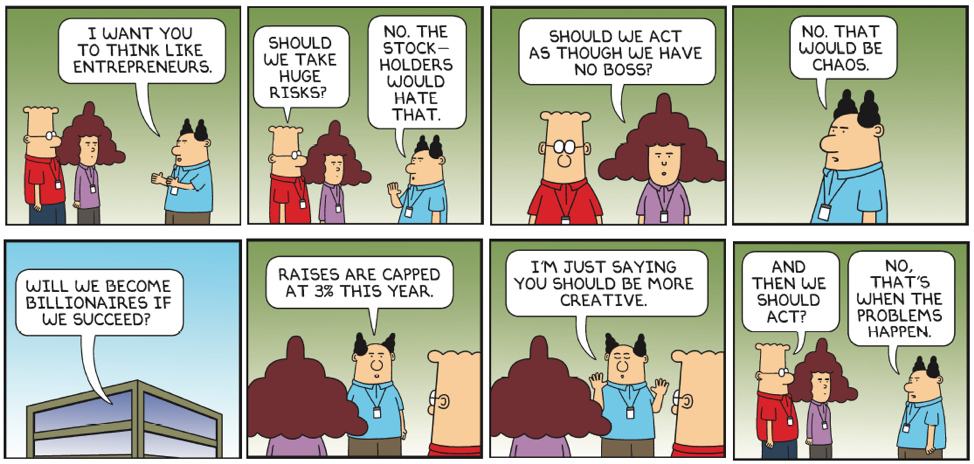Steve Blank once famously said: “We now know something we didn’t know before: startups are not smaller versions of large companies.”
He goes on to expound on the difference between searching for a repeatable and scalable business model (a core startup activity) and executing a known business model (a core big company activity). This distinction is a foundational Lean Startup concept.
As corporations have rushed to adopt Lean Startup principles for their innovation teams – generally a good idea – they make a big mistake in thinking they should or can simply “act like a startup.” They forget an unstated corollary to Steve Blank’s big idea: a corporate innovation team is not just a larger or better-funded version of a startup.
Our team at the UC Berkeley Innovation Acceleration Group runs accelerators all over the world both for teams inside corporations (our Internal Corporate Innovation or ICI programs) and for collections of startup teams (our Scaling Startup Ecosystems or ESE and Enterprise Startup Engagement or ESE programs).
We frequently hear from potential corporate clients that they want to help their internal employees “behave more like entrepreneurs.” This concept sounds good, and I think most of the corporates mean it in a good way.
The reality we have seen in the field, though, is that the best outcomes occur not when corporate employees truly behave like entrepreneurs, but when they behave like effective corporate innovators.

So, what is the difference?
Launching new products, services, and business models inside corporations is fundamentally different from launching startup companies, though they share some superficial elements in common. Some of the elements the two types of launch processes share include the fact they are best served initially by a small cross-functional team engaged in – as Steve Blank has told us – a systematic search process seeking a repeatable and scalable business model.
Also, on corporate innovation teams – just as on startup teams – job titles should be largely irrelevant: all team members should be responsible for doing the work of the project and all should contribute and be heard in the process of customer discovery.
First, I want to establish a couple of key guiding principles that underlie all of our work with teams launching new products services and business models.
1. Most ideas for new products, services and business models are bad ideas and won’t succeed.
2. The value of killing a “bad” idea quickly is as great as – or maybe greater than – the value of identifying a winning idea.
With these principles in mind, I want to explore some of the ways being an effective corporate innovation team differs from startup life.
In some ways, startups have greater flexibility than corporate innovation teams, and this flexibility is often cited as an advantage startups have over large companies. For example, when the customer discovery process inevitably leads to changes and pivots to the new business idea, in theory a startup can go wherever its customer interview process leads. A corporate team, in contrast, is typically constrained by the boundaries of an existing overall corporate strategy.
Also, there is always the possibility a team will discover solid and compelling product-market fit for a business model that will yield revenues and / or profits that can sustain a startup but are not large enough to warrant a corporate investment in the business. In this case, again, conventional wisdom holds that the startup has an advantage as they can chase a business the large company won’t (and shouldn’t)
.
But remember, the success of the whole lean customer discovery and business model validation / invalidation process includes not only accelerating toward more effective “go” decisions, but also avoiding untold lost opportunity costs by accelerating justified “no-go” decisions. Getting excited about the wide-open playing field of a startup misses the great value that comes to corporate innovators when they maintain focus.
The day the agile corporate innovation team discerns the available market for a new offering is either too small to be interesting, or too far outside the company’s strategy to pursue, is the day all members of that team can begin a new search process to find a better opportunity for their company.
Embracing the realities of their situation make corporate teams more efficient in their customer discovery and business model validation process than startups. When corporate teams ignore these constraints and try truly to “act like entrepreneurs” they frequently come away from the process having learned the systematic search process, but with a false “go” recommendation that shouldn’t and probably won’t be implemented. Their time would have been better spent embarking on a new search, and this result can hurt the team’s credibility across portions of the larger organization.
In addition to the greater search efficiency the corporate context allows, corporate innovators also have distinct advantages over startup teams in executing their business model validation processes – but if and only if the team fully embrace these advantages and use them instead of pretending they are a startup.
One thing corporate teams need to remember, for example, is that they have assets startups don’t have – beyond just money – which can help them execute their search.
A few key resources large companies have and can use in their customer discovery process, which are not available to startups include:
1. Brand recognition and credibility
2. The knowledgeable population inside their own company
3. Existing customer relationships and familiarity with industry purchasing processes
A while back, I helped teach an Internal Corporate Innovation accelerator at a large company. One team asked “should we conceal where we work and pretend we’re a startup during our customer interviews?” The answer, of course, was “it depends.” Specifically, it depends on what you are trying to learn from that particular customer interview. There are cases where the team needs to get information that might get skewed by the interviewee knowing where the team works.
More common, though, is the situation I saw with another large corporation (I’ll call them “Brand X”), where a team came back from their field interview work in an entirely new industry for the company, and reported that multiple customers had told them “We’re really happy someone from Brand X is asking us about these things; up ‘til now the only people talking to us about it have been startups, and we just can’t work with a young startup on something this important to our business.”
There are a lot of conservative markets where the customers can’t or won’t work with startups, either by preference or by rule. Companies thinking about launching new products, services and business models frequently ignore or forget the power of their own brands, even outside their existing market segments, for creating credibility and providing access. Corporate innovation teams have the opportunity to exploit this strength if they are willing to embrace it.
One key success factor in the customer discovery process is access to “customers” – i.e. people the team can reach and talk to, who have information and insight about the problems and pains in the status quo in their market.
Beyond brand recognition, other forms of “access advantage” corporate innovators enjoy over startups include access to the people in their own company and access to their company’s existing customers.
Any time a corporate innovation team embarks on a systematic customer discovery process, they should immediately scour their company roster for people who have experience working in or with the markets or specific customer segments they believe will be receptive. Exploratory conversations with these people can accelerate the team’s focus and increase early productivity, and they can be a powerful source of contacts and introductions to the people on the outside who will provide the next level of insights and evidence about the team’s business model hypotheses.
Having innovation teams inside a company talk to people at the company’s existing customers is a powerful step that, unfortunately, sometime scares influential people in the company. The typical fear is that an innovation team seeking information to validate or invalidate hypotheses about a potential new business model will somehow damage the relationship with the customer. Sometimes there is an account team who wants to mediate every communication with the customer (which would destroy the value of the customer discovery interviews).
In my experience, however, the customer relationships can be enhanced and deepened by saying “we are constantly exploring new ways to create value for you and our other customers, we recognize you as leaders and we value your experience and opinion so much we want to talk with you about what is and is not working for you to inform our potential future product or service launches.”
Of course, the team needs to be sensitive, but by keeping true to their mission of research and discovery, without selling or pushing ideas, they will help their own search process and may even deepen the customer relationship.
Embracing the realities of living in a large company, and using these strengths to their advantage, can help corporate innovation teams work more efficiently and create faster and greater benefits for their company, both through accelerating time to market for winning ideas, and accelerating time to cancelation for the ones with no future.
Pretending to be a startup and seeing where it leads is a less effective path for corporate teams.
This is a guest post by Mark Searle, Managing Director at UC Berkeley Innovation Acceleration Group. Mark will be hosting a 90-min workshop on this topic during Innov8rs Miami, 20-21 February 2019 – join him there!


